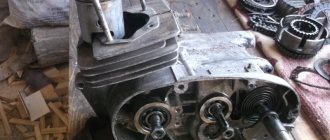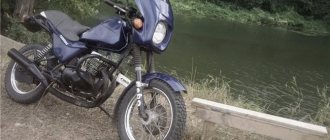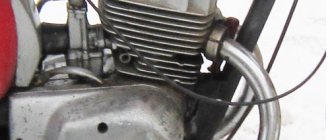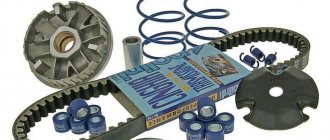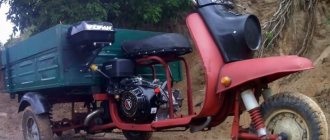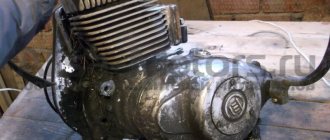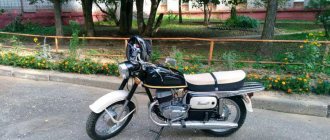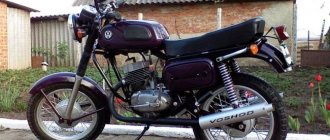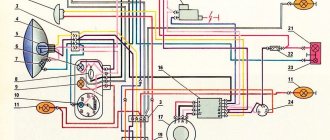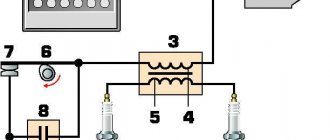It is not clear why Voskhods have gained fame as unreliable and capricious motorcycles. You might think that Jupiter or Ant is much better than Sunrise. However, this opinion still exists in the motorcycle community. Well, okay, if there is such an opinion, then so be it.
Someone had already “overhauled” the engine before us, then we drove it a little, removed the cylinder for boring and rolled it into the garage for the winter. While the motorcycle was standing in the barn, water began to flow into the engine... And when spring came to the yard, the owner wanted some drive... Well, let's give him some drive.
Description
Motorcycle engine Voskhod 3M single-cylinder, two-stroke with a volume of 173.7 cubic centimeters. The cylinder diameter is 61.7 millimeters. The piston stroke is 58 millimeters. The maximum power in kilowatts is 9.9, and in horsepower it is 13.5. The cylinder, piston, crankshaft and main bearings are lubricated with gasoline and oil. Engine oil is poured into the box and clutch and checked with a dipstick.
Removing the generator
We slightly unscrew the generator rotor mounting bolt, attach the rotor with a puller, rest the puller bolt against the rotor mounting bolt and pull the rotor off the crankshaft axle
We pick out the key and put it somewhere away. Help: painted oil seals are a sure sign of collective farm repairs (experience)! If you decide to buy a Voskhod and see that the seals are painted, check the engine a hundred times and only then agree to purchase.
Engine diagram Voskhod 3m
1 – spark plug A23; 2 – cylinder head; 3 – cylinder head gasket; 4 – cylinder; 5 – piston ring; 6 – piston; 7 – piston pin; 8 – needle bearing; 9 – cylinder gasket; 10 – connecting rod; 11 – bearing lubrication channel; 12 – ball bearing; 13 – right crankshaft oil seal; 14 – right main crankshaft journal; 15 – generator; 16 – movable gear of the second gear; 17 – primary shaft with gear; 18 – main gear; 19 – gearbox and clutch housing; 20 – clutch release rod; 21 – pin of the clutch release mechanism; 22 – gearbox oil seal; 23 – reverse gear sprocket; 24 – generator cover; 25 – crankcase (right half); 26 – gear shift shaft; 27 – crankcase (left half); 28 – trigger shaft; 29 – trigger spring; 30 – trigger sector; 31 – trigger gear; 32 – trigger ratchet; 33 – kickstarter shaft oil seal; 34 – kickstarter shaft oil seal cap; 35 – kickstarter lever; 36 – gear shift lever; 37 – clutch disc; 38 – adjusting screw; 39 – internal clutch drum; 40 – leading clutch disc; 41 – outer clutch drum; 42 – left main crankshaft journal; 43 – front drive sprocket; 44 – chain PV-9.525-1300; 45 – clutch cover; 46 – left crankshaft oil seal; 47 – ball bearing; 48 – bearing lubrication channel.
Source
Disassembling the clutch
Removing the clutch cover
Checking the motor circuit
We put pressure on the motor chain and see how much it has sagged: if the chain sag by more than 15 mm, we immediately throw it in the trash.
In our case, the motor chain is ideal: there is practically no sagging
Removing the clutch basket springs
Remove all discs from the basket. After removal, check the discs for wear and warping.
We take out the clutch rod
We weld a rod or piece of tire to the old unnecessary clutch disc, unbend the lock washer under the nut of the inner drum of the clutch basket, fix the inner drum with a puller and unscrew the nut (left-hand thread)
First joint
Someone put a washer under the inner drum
Place a tin block or stick under the chain and unscrew the nut (right-hand thread)
The sprocket sits on a cone and can only be removed with a puller
Removing the basket
Remove the adjusting washers from the shaft and pick out the second key
Motorcycle engine repair Voskhod
The Sunrise is a road bike. It was very popular in Soviet times, but is no longer produced. The most popular model is considered the Voskhod 3M, an engine whose repair is completely simple and completely easy to maintain. The reliable design and stability of the bike make Voskhod an excellent friend for any motorcycle enthusiast.
Since nowadays you can only buy such a motorcycle second-hand, you have to tinker with the technical part of the motorcycle. You will be very lucky if the previous owner kept the bike clean and used it according to recommendations. If not, then frequent repairs of the Voskhod engine will take up your free time.
Voskhod 3M is considered a direct competitor to the YAVA 350 motorcycle. However, Voskhod breakdowns happen an order of magnitude more often. This happens mainly due to the negligence of the owner. Failure to follow operating instructions leads to minor problems that create significant problems. A special feature of 3M is the chassis. The brake pads were equipped with a wear sensor, the shock absorbers were fitted with corrugated rubber covers , and a protective shield was installed on the front wheel. The design of the Voskhod 3M engine also changed slightly after the modification was released. Motor 3M-01 with five-channel cylinder purging and one exhaust window.
Engine diagram
For Voskhod motorcycles, the engine size was the same. It was 173 cm3. In general, all bikes from this manufacturer had the same single-cylinder engine with two power strokes and an air cooling system. The very small volume of the engine produced 10 horsepower and over time, modifications to the engine began to produce power of 14 hp.
If you discover a malfunction and it is related to the operation of the engine, do not put off repairs for a long time. Exacerbating the problem will result in unexpected costs. There is no need to be afraid to overhaul the engine. Not only disassembly, but also assembly of the Voskhod engine is very simple.
Before repairing, carefully inspect the motorcycle for wear or broken parts. After inspection, clean the engine from dirt. It is better to wash it thoroughly with a cleaning agent. Since the main engine problem is the crankshaft bearings, seals and gaskets, let’s consider the process of repairing them:
- First, let's look at installing the crankshaft bearings. To do this, it is necessary to install retaining rings in the pallet halves. Then, using mandrels, insert the main bearings. If you have not done such repairs before, the Voskhod engine diagram will help. The crankshaft moves into the new bearings with force, which creates additional load on the ball bearing axle when moving.
- Insert the crankshaft into the left side of the pan. To prevent the connecting rod from rotating, secure it, otherwise there is a risk of bending it.
- Turn the motor over. We put a pin on the nuts and screw the resulting element onto the studs.
- Pressure must be created on the bearing from the inside. Any bushing that fits the size will do for this. If you choose the wrong size, it will come off and disrupt the operation.
- Once the bearings and bushing are securely installed, we move on to the crankshaft. Tighten it at a distance of no more than 3-4 millimeters from the crank chamber partition.
- Now take a thin rod and move it between the crankshaft and the crank chamber until it passes without much force.
- Remove all fat from the surface of the pan. We lay new gaskets and connect the halves of the pallet to each other, putting the second part on the axle.
Engine disassembly
We unscrew the bolts holding the crankcase together. There should be 14 bolts
We heat the crankcase connector with a hairdryer, apply gentle blows to the protruding shafts through a wooden spacer until the engine is halved
The third jamb
The crankcase gasket was installed crookedly, so much so that it did not even cover the crank chamber connector
Jamb four
The main bearing was closed. He died quickly
Fifth jamb
The gearbox secondary shaft bearing was not assembled correctly: the rollers should be separated by a ring, but on this engine a ring was not installed between the rollers
So much for a major “repair”, the painted oil seals are proof of this. Now think: is it worth buying a motorcycle after a major overhaul or is it better to buy one that has been worn out, but has never been chipped.
Source
Force
To increase power on Voskhod 3M, you can do engine tuning yourself. Even simple manipulations like an air filter can increase performance.
For a stronger increase in power, you can replace the intake system. For example, install a new carburetor. Perhaps even from another motorcycle with a similar system. There is an option in which you can install two carburetors, but you will have to connect pipes to it and weld the channels, filling the cracks with epoxy liquid.
Modern look
Along with the increase in power characteristics, there is a need to improve the appearance of the unit: installing a new panel, nickel-plated arches, fairings. One of the popular options for tuning a 3m sunrise among drivers is to convert the sunrise to a cross.
The advantages of this option are that the cross bike moves well off-road, is easy to control and does not require fundamental design changes.
Complete disassembly of the Voskhod motorcycle engine - we do it ourselves
It is not clear why Voskhods have gained fame as unreliable and capricious motorcycles. You might think that Jupiter or Ant is much better than Sunrise. However, this opinion still exists in the motorcycle community. Well, okay, if there is such an opinion, then so be it.
Someone had already “overhauled” the engine before us, then we drove it a little, removed the cylinder for boring and rolled it into the garage for the winter. While the motorcycle was standing in the barn, water began to flow into the engine... And when spring came to the yard, the owner wanted some drive... Well, let's give him some drive.
List of improvements to my Voskhod-3m
Good day guys, I haven’t been here for a long time, but nostalgia for the bike and all sorts of modifications left no rest and I decided to write a little about my 3M, some relevant information.While buying oil in Sokolniki, I saw a bike covered with stickers, I saw cars around the city that either had the bumper or mirrors covered, but I didn’t know where to buy such stickers, after talking with the owner of the bike, I decided to try it, to see what would come of it (I’m one of those , who prefer good painting to a good appearance, rather than all kinds of stickers, but at the moment I decided to try it anyway). You can buy stickers on the website (Bombme.ru).
I changed the light bulb in the headlight, installed a Narva H4 60/55 W light bulb through an adapter, the light is noticeably brighter than with the standard lamp.
In the headlight I installed an LED instead of a headlight bulb.
The footrest of the motorcycle was modified/extended; with the old (short) one, the motorcycle constantly fell and broke off, then the turn signals, then the clutch and front brake handles, well, in general, this gave rise to coming up with something.
LED engine illumination, illuminated in orange, can be forcibly turned off by a switch if desired.
The Brisk N17 engine spark plug is my favorite. Stability and engine starting with this spark plug are quite good.
The steering wheel was bought in Sokolniki, if I’m not mistaken it was called Z-bar (something like that), but I had to weld a jumper, this steering wheel was not stiff enough.
The speedometer scale and backlight have been redone, the speedometer backlight is orange with a forced switch off on the instrument panel.
At the moment, the bike has traveled 30,000 km, the speedometer on it was changed at 28,000 km, for the purpose of an upgrade.
It shines quite brightly, no different from a lamp, except for the speed of flashing, LEDs a priori flash faster and consume several times less.
The L-328 (Petroshina) tires have the advantage of rowing much better than the standard Voskhod ones, but are a bit noisy on asphalt. The front has a lower profile model L-240, also Petroshin tires.
The oil I pour into the tank is Motorrad 2T from Liqui Moly, I want to try driving a Motul 510 2T. The box is filled with M8 oil, I plan to try using Motul Transoil 10W30.
Switch: For Voskhod 3m with a 90W generator, instead of the standard already discontinued switch number 70, the following switch is suitable (see photo below), it starts up on it the same way as on the standard one, bought in Sokolniki.
The engine was painted matte black with heat-resistant paint (Kudo enamel is heat-resistant up to 650 degrees).
What else can I say, perhaps in the future I will paint it in the workshop with a traditional light green gloss, tearing off all the stickers, but at the moment it is in this condition. The engine is very fast, even taking into account the mileage of 30,000, although the rings were replaced, no modifications were made to the engine, because I want to ride and not repair the bike due to failed spare parts after boosting (I prefer proper running-in and ignition settings in conjunction with a carburetor rather than boosting the engine). On a cold engine the clutch moves a little, but when the engine warms up all the power is transferred to the wheel and the clutch stops moving.
The average comfortable speed is 75-80 km/h, the maximum is 90 km/h. I also plan to fill the tank with a fuel preserver for the winter, otherwise in the spring it will be very difficult to start the engine. Well, in general, probably everything I wanted to tell about my 3M, maybe I forgot something, then I’ll add it later. Thank you all and good mood))!
Replacing clutch discs
You can replace motorcycle clutch discs very quickly. The first thing you need to do is drain the oil from the engine, but we won’t drain it. You just need to place the motorcycle on its right side on the ground.
Motorcycles Voskhod, Voshod-2(M) and Voshod-3(M) were produced from 1965 to 1993 and were distinguished by excellent technical and operational qualities for their time. All of them were equipped with 173 cc two-stroke engines, which had one air-cooled cylinder and carburetor power. This allowed the motorcycle, depending on the modification, to reach a maximum speed of 90-105 km/h with a fuel consumption of no more than 4.5-5.5 liters per 100 km. In general, Voskhod has established itself as a reliable and durable vehicle, capable of operating for many years with proper maintenance. However, time takes its toll, and the need to repair Soviet equipment arises more and more often. Let's try to figure out what features are characteristic of restoring the main components and assemblies in the process of repairing a Voskhod motorcycle.
how to adjust fuel consumption in a K62V carburetor. Sunrise 3m
The quality adjusting screw is fully tightened, and then unscrewed half a turn or a little more. After starting the engine, warm it up to normal temperature.
By rotating one quantity screw, the minimum stable engine speed is achieved, by rotating the other (quality screw) the mixture is leaned until interruptions occur. After this, turning the quality wing, enrich the mixture until the engine begins to operate stably. Now, turning the screw from which the adjustment began, reduce the speed and find a new position for the quality screw and repeat this until a minimum but stable engine speed is achieved.
The correct idle speed adjustment is checked by sharply opening and closing the throttle. If the engine stalls when the throttle is opened suddenly, you should enrich the mixture by turning the quality screw a quarter or half a turn. If the engine stalls when the throttle is closed abruptly, the mixture is leaned out by turning out the same quality screw by the same amount.
Engine
The “heart” of a motorcycle, even with the most careful use, gradually wears out - this is facilitated by the abundance of heterogeneous mechanical loads in the cylinder-piston group and other moving parts, temperature effects on the metal, the chemical composition of the working mixture and exhaust gases. DIY motorcycle repair Voskhod most often includes the following engine work:
- removing the power unit from the motorcycle frame;
- partial or complete disassembly of the internal combustion engine;
- replacing piston rings;
- restoration of the cylinder mirror;
- repair or replacement of the piston, connecting rod, crankshaft;
- replacement of support bearings, liners, seals;
- lubrication, fastening, adjustment work.
Engine repair, like the repair of other units, must be preceded by a comprehensive diagnosis of its technical condition, which includes an analysis of operational parameters (approximate indicators of developed power and speed, fuel consumption, sound of operation, color and character of the exhaust). If necessary, diagnostics are performed on the bench, and specialized instrumentation is used.
It is important to navigate the structure of a two-stroke internal combustion engine of a motorcycle and understand how each specific type of repair is performed. So, when replacing piston rings, you can do without removing the engine. It is enough to unscrew the stud nuts, remove the cylinder cover and, opening access to the piston, bring the piston to top dead center. Then the worn rings are removed and new ones are installed. The engine is assembled, not forgetting to replace the gasket. This completes the repair.
Photo report: Installing a piston on a motorcycle “Izh”, “Ant”, “Voskhod”
In matters of choosing one or another engine repair strategy. When it comes to repairing Soviet two-stroke motorcycles, it is advisable to adhere to a strategy that involves the complete restoration of original parts. And if this is not possible, with a creaky heart, you are forced to buy counterfeit goods or look for a used option.
- In the case of piston engines, a good repair involves, first of all, boring the cylinder to the repair size and installing a new piston, rings and pin. If you are lucky enough to find a Soviet-made cylinder, the best option would be to bore it to repair size, install a new piston, albeit a counterfeit one, and then such a piston is guaranteed to last for several seasons. And what’s most important is that boring costs only 400 rubles + a new piston, rings, pin, the total cost is no more than 1000 rubles
There is little point in dwelling on the boring process in detail. Boring involves restoring the geometry of the cylinder by increasing its diameter. You don't need to know more about boring. There are turners, let them bother with these subtleties
- If you don’t bother, as they used to like to do on collective farms: choosing a larger piston for a worn-out cylinder, then such a “repair” will be enough to take you to the neighboring collective farm for moonshine a couple of times...
- The fastest repair option is to buy a new piston. Our prices for piston engines for Soviet motorcycles start at 3,000 and more. To buy or not to buy is up to you. But if you buy it, be prepared for surprises.
Ignition and carburetor
It is these two components that, as a rule, determine the stability of the engine. Often, interruptions in the crankshaft rotation speed, loss of traction, and difficulties starting the engine are associated precisely with their malfunctions. Repairing the ignition and carburetor usually comes down to adjusting them. Setting the ignition includes setting the gap between the coil core and the sensor magnet within 0.295...0.305 mm. The piston ignition timing should be 3.5-5 mm to top dead center. Adjusting the carburetor is somewhat more difficult. If you are repairing a Voskhod-3M motorcycle, then you will have to deal with the K65V carburetor, and the main tools will be the quality and quantity screws included in its design. Using the first, you can lean or enrich the mixture - change the proportion of fuel and air entering the cylinder. The second determines its volume per working cycle. With the standard setting, the quality screw is screwed in completely and then unscrewed half a turn. Then the rotation of the quantity screw achieves the minimum stable speed and the quality of the mixture is re-adjusted. Finding the optimal adjustment balance is a search for maximum traction and stability with minimum fuel consumption.
Preparation
Russian is Russian, so until we process all the parts properly with a file before installation, nothing will work out...
Insert the cylinder rings and use a feeler gauge to measure the gap in the lock.
- If the gap is less than normal, file the ends of the rings with a file
To reduce engine noise and speed up the ring grinding process, remove small chamfers on their working edges (preferably)
To improve lubrication of the piston pin, use a 5-6 mm drill to drill through holes in the piston bosses (optional)
We remove flashes and deposits of metal in the cylinder windows and round the edges along which the rings go
After finishing work, we thoroughly wash all the parts, prepare a clean work area and begin assembly.
Removing the piston
We unscrew the four nuts on the head, remove the head from the studs, remove the cylinder, remove the retaining ring from the piston boss, push out the piston pin, remove the piston and remove the separator
Tuning options
Refinement of the design involves internal or external tuning. During internal modifications, the engine is rebuilt, driving parameters, suspension, and brakes are optimized. When external modifications are made, the motor vehicle is given a sporty style or it is converted into a chopper.
Features of internal tuning
Owners often rework the Voskhod-3M engine. To increase engine thrust, the factory paper air filter is replaced with foam filter elements. This helps reduce air exhaust friction. Then the jets and diffusers are polished using an abrasive material, the diameter of which affects the volume of fuel entering the engine.
To improve the fuel exhaust system, a new modernized carburetor is installed. From the existing pipe, take flanges for mounting on the cylinders, grind out aluminum bushings, and cut off the flange from the exhaust pipe. In an old carburetor, take a second flange. Using cold welding, the parts are connected.
The design is adjusted until it fits perfectly into the exhaust channels. Internal gaps are filled using epoxy glue.
Often rear adjustable shock absorbers are installed and sports tires are installed. When performing such tuning, the motorcycle becomes more aggressive and sporty.
Performing external tuning
In a sporty style
With a low seating position and a high front fork, there is a desire to modify the motorcycle in accordance with the sporty style. To do this, raise the rear shock absorbers and replace the exhaust pipe elbow. This way the exhaust pipe is level with the rear axle. Exhaust pipes with a larger diameter will improve the design and increase the traction of the bike.
External modifications can include painting, chrome plating, installation of nickel-plated arches instead of the old factory protection, installation of large rear-view mirrors, stepped seats and wheel tuning.
At the end of the tuning, a sports fairing is installed.
Chopper
When performing tuning for a chopper, shortened rear shock absorbers are cut off or purchased. Thanks to this replacement, the rear of the motorcycle will be lowered by several centimeters. The rear fork and wheel are replaced with wider ones. The angle of inclination of the front fork axis is replaced, and the cylinder covers are equipped with chrome plated cups. The same style is followed when tuning the headlights, rear lights, and dashboard.
Tuning for Cafe-bike
With such a modification, to reduce costs, they weld the rear part of the frame with their own hands, shorten the fork, trim and adjust other parts. For the steering wheel and seat, your own strength may also be sufficient. A headlight with a brake light is installed from trucks.
Most owners can carry out tuning on their own using only purchased parts due to the simplicity of the designs and the low cost of spare parts.
Appearance tuning
As for appearance, the list of improvements can be divided into three groups:
- Restoration.
- Finalization.
- Major changes.
Today, the most popular is restoring the factory appearance of a sunrise motorcycle. As we have already said, retro motorcycles, which have become fashionable, are very popular among both young people and older people. Moreover, literally every element is subject to recovery and restoration. The motorcycle is disassembled down to the bolts and then reassembled.
And in this article you can learn how to make an ATV in your garage. Manufacturing technology, selection of spare parts and many secrets of construction.
Those who chose this vehicle not as a tribute to fashion, but as a practical motorcycle, prefer to modify the appearance. The improvements include those elements that this motorcycle is so lacking: a dashboard, roll bars, panniers, high-quality lighting.
This is a common problem with all Soviet motorcycles - in the pursuit of power, the manufacturer forgets that it should look decent. Fans of the most varied tuning of the Ant scooter also face this situation. If desired, it can be easily transformed, giving it a modern and stylish look.
Last but not least is the radical tuning of the appearance of the Voskhod motorcycle. Here we will place improvements that affected major components and frame geometry. Some craftsmen manage to convert this road motorcycle into a full-fledged cross-country or enduro motorcycle. A new tank is installed, the tail of the motorcycle is lifted up, and sports shock absorbers are replaced. The most experienced Kulibins integrate a mono shock absorber from Japanese motorcycles into the rear suspension. On the other hand, modifications to the chopper style. Here, a long front fork and a thicker rear wheel invariably appear. Together with the high handlebars and forward footrests, the landing turns into a lordly one. All that remains is to get a huge seat and you can absorb kilometers of roads.
